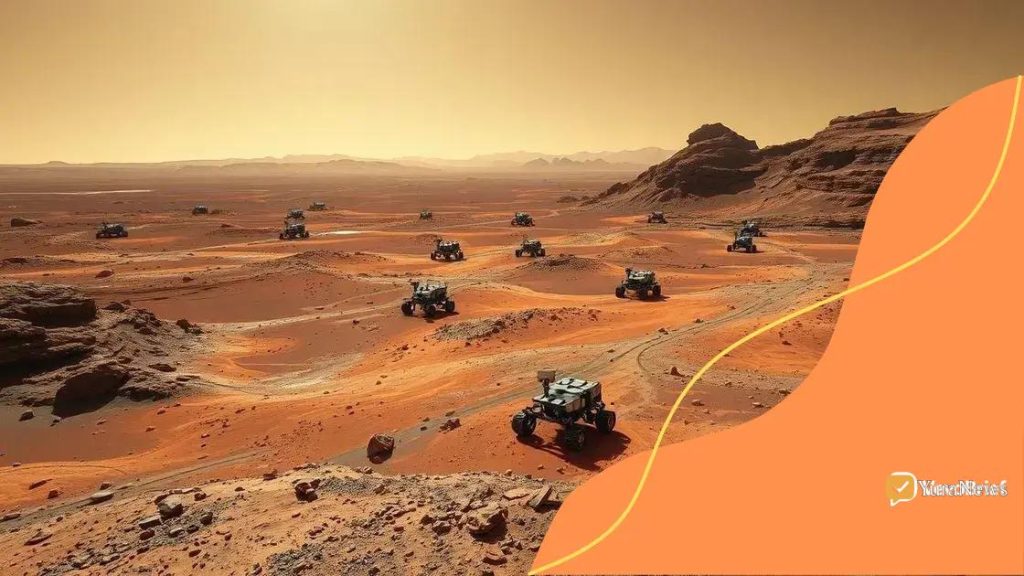NASA’s latest Mars mission reveals intriguing discoveries

Anúncios
NASA’s latest Mars mission yields new findings, including evidence of past water, advanced geological insights, and public engagement, all paving the way for future exploration and understanding of potential life on the red planet.
NASA’s latest Mars mission has not only captured our imagination but also provided valuable insights into the red planet. As we delve into these new discoveries, one can’t help but wonder what they mean for our quest to understand Mars better.
Anúncios
Overview of NASA’s Mars mission
The Overview of NASA’s Mars mission provides a fascinating insight into the ambitious efforts to explore the red planet. This mission aims to uncover the mysteries of Mars and assess its potential for supporting life. NASA has employed state-of-the-art technology and innovative techniques to gather crucial data about Mars’s environment and geology.
Mission Objectives
The primary goals of NASA’s Mars mission are to investigate the planet’s surface and atmosphere. Understanding these elements can help scientists learn more about Mars’s past and whether it was ever hospitable to life. Moreover, the mission focuses on searching for signs of ancient microbial life.
Key Technologies Used
To achieve these objectives, NASA has deployed a variety of advanced technologies:
Anúncios
- Rovers: Equipped with scientific instruments that analyze soil and rock samples.
- Orbiters: They capture detailed imagery and data from above, providing a comprehensive view of the landscape.
- In-situ analysis: Instruments that can measure and test Martian materials directly on the surface.
Through these technologies, NASA can gain a much deeper understanding of Mars. For instance, the rovers have been instrumental in uncovering geological formations that tell the story of water flow in the past.
The mission has also ignited public interest in space exploration. People are eager to learn about discoveries made on Mars, and NASA has been actively engaging them through social media and educational initiatives. This enthusiasm fuels further investment in space science and technology.
Key findings from the mission
The Key findings from the mission shed light on some of the most important discoveries made during NASA’s exploration of Mars. These findings not only enhance our understanding of the planet but also provide new insights into the possibility of past life.
Discovery of Water Sources
One of the most exciting revelations is the presence of water in various forms on Mars. Scientists have identified ancient riverbeds and mineral deposits that suggest flowing water once existed. This discovery raises the possibility that Mars could have supported microbial life in its history.
Geological Insights
The mission has also provided a wealth of geological data. The rovers have analyzed soil and rock samples, revealing diverse mineral compositions. Key findings include:
- Clay minerals: Indications of long-term water interactions.
- Salt deposits: Evidence that liquid water may have been present for extended periods.
- Rod-like structures: Possible biosignatures that warrant further investigation.
Understanding these geological features is critical. They allow scientists to piece together Mars’s climatic history and assess its habitability over time.
The analysis of atmospheric conditions has also advanced significantly. Measurements of methane levels have sparked debates about potential biological activity, as methane can be produced by both geological and biological processes. Continuous monitoring will deepen our understanding of what these fluctuations mean for future exploration.
Overall, these key findings not only enrich our knowledge of Mars but also inspire future missions. They pave the way for more advanced studies to determine if life has ever existed on the planet.
Implications for future research

The Implications for future research arising from NASA’s Mars mission are significant. These findings not only deepen our understanding of Mars but also open the door to new avenues of exploration and study.
Guiding Future Missions
First, the discoveries from Mars will guide the objectives of future missions. For instance, knowing where water sources are located can help focus on areas where life may have existed. Scientists are particularly interested in landing sites that showcase signs of ancient life, which could lead to transformative discoveries in astrobiology.
Technological Advancements
The mission has accelerated technological advancements in space exploration. The tools and techniques developed will enhance the capabilities of future rovers and landers. Key advancements include:
- Sample collection techniques: Improved methods for gathering and storing Martian samples for return to Earth.
- Sensing technology: More precise instruments for analyzing atmospheric conditions and surface materials.
- Autonomous navigation: Enhanced ability for rovers to navigate challenging terrains without constant control from Earth.
With these advancements, future missions will be more efficient and capable of performing complex tasks.
The ongoing analysis of Mars’s climate and geology has prompted discussions about human exploration as well. Understanding the Martian environment is critical for the planning of manned missions. This involves studying radiation levels, atmospheric pressure, and the availability of resources like water and air.
Exploring Mars also has profound implications for our understanding of life beyond Earth. The research emphasizes the need to look for biosignatures not just on Mars but on exoplanets. This can help scientists search for life in places previously thought uninhabitable.
Technological advancements utilized
The technological advancements utilized in NASA’s Mars mission have been pivotal for gathering valuable data and achieving mission goals. These innovations are not only impressive but also signify a leap forward in space exploration capabilities.
Advanced Rover Technology
One of the key pieces of technology is the rover itself. The rovers are equipped with advanced tools that allow them to explore the Martian surface. Notable features include:
- High-resolution cameras: These cameras capture detailed images of the landscape and analyze features of interest.
- Sample collection systems: Rovers can collect soil and rock samples for further analysis.
- Robotic arms: These arms allow for precise manipulation of instruments to conduct experiments.
These technologies enable rovers to study various aspects of Mars, including its geology and potential habitability.
Remote Sensing Technology
Another area of advancement is remote sensing technology. Instruments aboard orbiters provide crucial information from above, such as:
- Spectrometers: These measure the chemical composition of Martian rocks and soil.
- Thermal imaging: Helps identify temperature variations, which can indicate subsurface water and ice.
- Atmospheric sensors: Monitor the Martian atmosphere for changes and help detect methane levels.
This remote sensing data is essential for understanding the planet’s current state and its history.
Additionally, the mission employs advanced navigation and autonomous systems. These allow rovers to travel long distances over rough terrain without needing constant control from Earth. Such independence is crucial for exploring areas that are difficult to access.
All these advancements combined have not only improved the efficiency of the mission but have set the stage for future exploration plans. These technologies will be instrumental in making future manned missions to Mars a reality, significantly enhancing our ability to explore the universe.
Public interest and engagement with Mars exploration
The public interest and engagement with Mars exploration have significantly surged in recent years. As NASA’s missions unfold, more people are captivated by the mysteries of the red planet. This interest is crucial for the future of space exploration as it fuels funding, research, and education.
Increased Media Coverage
Media coverage of Mars missions plays a huge role in shaping public perception. Television shows, documentaries, and online content showcase the wonders of Mars. Social media platforms have become vital tools, allowing NASA to share real-time updates and amazing images from the rovers.
Public Engagement Activities
Nobody can ignore the excitement when NASA conducts live events. These events attract thousands of viewers and encourage participation. Opportunities include:
- Live Earth-to-Mars events: Viewers can watch missions as they happen and ask questions.
- Citizen science projects: People can help analyze data and images, contributing directly to research.
- Educational programs: Schools and institutions create workshops and activities centered around Mars, inspiring young minds.
These initiatives help bridge the gap between scientists and the public, making space exploration relatable and exciting.
Furthermore, the allure of potential discoveries, such as finding evidence of past life, captivates the audience’s imagination. People often dream of what human exploration would look like and what we might find on Mars. This curiosity keeps the conversation going and encourages further investment in space science.
Overall, public interest in Mars exploration not only fosters a sense of connection to the cosmos but also emphasizes the importance of international collaboration in space research. As more countries advance their own Mars missions, global interest will likely continue to grow.
FAQ – Frequently Asked Questions about NASA’s Mars Mission
What are the main discoveries made by NASA’s Mars missions?
NASA’s Mars missions have discovered evidence of water, identified geological features, and investigated the planet’s atmosphere, enhancing our understanding of its past.
How has technology advanced through Mars exploration?
Technological advancements include improved rovers with advanced sensors, sample collection systems, and enhanced remote sensing capabilities for better data analysis.
Why is public engagement important in Mars exploration?
Public engagement increases interest and support for space missions, helping to inspire future generations and secure funding for ongoing and future research.
What implications do current findings have for future Mars missions?
Current findings guide future missions by identifying target areas for exploration and informing plans for potential manned missions to Mars, focusing on habitability and resources.